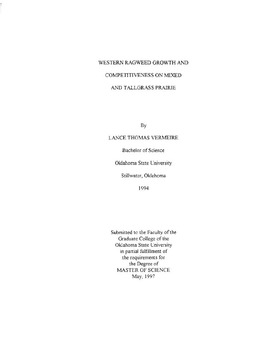Western Ragweed Growth and Competitiveness on Mixed And Tallgrass Prairie
| dc.contributor.author | Vermeire, Lance Thomas | |
| dc.date.accessioned | 2014-09-29T19:41:39Z | |
| dc.date.available | 2014-09-29T19:41:39Z | |
| dc.date.issued | 1997-05-01 | |
| dc.identifier.uri | https://hdl.handle.net/11244/12407 | |
| dc.description.abstract | A current trend in natural resource sciences is to study and manage entire systems as a single unit, somewhat de-emphasizing autecology. However, an imponant step in good management of rangelands, like any business, is to know the cost of each element affecting that business. Most often, because forbs comprise a small percentage the total production and at the same time the greatest percentage of species, they are studied and managed as an inclusive group on rangelands. Yet, Weaver (1954) showed that variations in growing season, rooting depth and root morphology can drastically alter plant interactions. Conclusions based on average responses of a complex group of plants may be incomplete and misleading. | |
| dc.format | application/pdf | |
| dc.language | en_US | |
| dc.publisher | Oklahoma State University | |
| dc.rights | Copyright is held by the author who has granted the Oklahoma State University Library the non-exclusive right to share this material in its institutional repository. Contact Digital Library Services at lib-dls@okstate.edu or 405-744-9161 for the permission policy on the use, reproduction or distribution of this material. | |
| dc.title | Western Ragweed Growth and Competitiveness on Mixed And Tallgrass Prairie | |
| dc.type | text | |
| osu.filename | Thesis-1997-V523w.pdf | |
| osu.accesstype | Open Access | |
| dc.type.genre | Thesis |
Files in this item
This item appears in the following Collection(s)
-
OSU Theses [15752]
